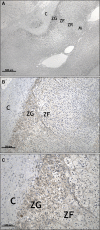ANO4 (Anoctamin 4) Is a Novel Marker of Zona Glomerulosa That Regulates Stimulated Aldosterone Secretion
- PMID: 31564164
- PMCID: PMC6791498
- DOI: 10.1161/HYPERTENSIONAHA.119.13287
ANO4 (Anoctamin 4) Is a Novel Marker of Zona Glomerulosa That Regulates Stimulated Aldosterone Secretion
Abstract
Microarray comparison of the transcriptomes of human adrenal zona glomerulosa (ZG) and zona fasciculata found several ZG-specific genes that negatively regulate aldosterone secretion. The third and most significantly upregulated ZG-gene (19.9-fold compared with zona fasciculata, P=6.58×10-24) was ANO4, a putative Ca2+-activated chloride channel. We have investigated the role of ANO4 in human adrenal, and whether it functions like the prototype anoctamin, ANO1. We evaluated ANO4 mRNA and protein expression in human adrenal by qPCR and immunohistochemistry, compared the effects of ANO4 and ANO1 overexpression on baseline and stimulated aldosterone secretion and cell proliferation in H295R cells, and analyzed ANO4 activity as a Ca2+-activated chloride channel in comparison with other anoctamins by a fluorescence-based functional assay. The expression of ANO4 in ZG was confirmed by qPCR as 23.21-fold upregulated compared with zona fasciculata (n=18; P=4.93×10-7). Immunohistochemistry found cytoplasmic, ZG-selective expression of ANO4 (anoctamin 4) protein. ANO4 overexpression in H295R cells attenuated calcium-mediated aldosterone secretion and cell proliferation in comparison to controls. The latter effects were in a different direction to those of ANO1. The functional assay showed that, in contrast to ANO1, ANO4 expression results in low levels of calcium-dependent anion transport. In conclusion, ANO4 is one of the most highly expressed genes in ZG. It attenuates stimulated aldosterone secretion and cell proliferation. Although belonging to a family of Ca2+-activated chloride channels, it does not generate significant plasma membrane chloride channel activity.
Keywords: Zona glomerulosa; aldosterone; anoctamins; cell proliferation; chloride channel.
Figures





References
-
- Nishimoto K, Tomlins SA, Kuick R, Cani AK, Giordano TJ, Hovelson DH, Liu CJ, Sanjanwala AR, Edwards MA, Gomez-Sanchez CE, Nanba K, Rainey WE. Aldosterone-stimulating somatic gene mutations are common in normal adrenal glands. Proc Natl Acad Sci U S A. 2015;112:E4591–E4599. doi: 10.1073/pnas.1505529112. - PMC - PubMed
-
- Azizan EA, Poulsen H, Tuluc P, et al. Somatic mutations in ATP1A1 and CACNA1D underlie a common subtype of adrenal hypertension. Nat Genet. 2013;45:1055–1060. doi: 10.1038/ng.2716. - PubMed
-
- Beuschlein F, Boulkroun S, Osswald A, et al. Somatic mutations in ATP1A1 and ATP2B3 lead to aldosterone-producing adenomas and secondary hypertension. Nat Genet. 2013;45:440–4, 444e1. doi: 10.1038/ng.2550. - PubMed
-
- Zhou J, Shaikh LH, Neogi SG, McFarlane I, Zhao W, Figg N, Brighton CA, Maniero C, Teo AE, Azizan EA, Brown MJ. DACH1, a zona glomerulosa selective gene in the human adrenal, activates transforming growth factor-β signaling and suppresses aldosterone secretion. Hypertension. 2015;65:1103–1110. doi: 10.1161/HYP.0000000000000025. - PMC - PubMed
Publication types
MeSH terms
Substances
Grants and funding
LinkOut - more resources
Full Text Sources
Medical
Molecular Biology Databases
Miscellaneous

